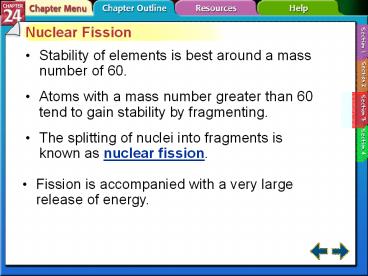Nuclear Fission - PowerPoint PPT Presentation
1 / 14
Title:
Nuclear Fission
Description:
Nuclear Fission Stability of elements is best around a mass number of 60. Atoms with a mass number greater than 60 tend to gain stability by fragmenting. – PowerPoint PPT presentation
Number of Views:393
Avg rating:3.0/5.0
Title: Nuclear Fission
1
Section 24-3
Nuclear Fission
- Stability of elements is best around a mass
number of 60. - Atoms with a mass number greater than 60 tend to
gain stability by fragmenting. - The splitting of nuclei into fragments is known
as nuclear fission.
- Fission is accompanied with a very large release
of energy.
2
Section 24-3
Nuclear Fission
- Nuclear power plants use fission to produce
electricity by striking uranium-235 with neutrons.
3
Section 24-3
Nuclear Fission (cont.)
- Each fission of U-235 releases three additional
neutrons.
- Each of those neutrons can release three more
neutrons. - The self-sustaining process is called a chain
reaction. - http//glencoe.mcgraw-hill.com/sites/007874637x/st
udent_view0/chapter24/concepts_in_motion.html
4
Section 24-3
Nuclear Fission (cont.)
5
Section 24-3
Nuclear Fission (cont.)
- There must be sufficient mass to get the chain
reaction started. If not the neutrons escape
before striking other nuclei. - Without sufficient mass, neutrons escape from the
sample before starting a chain reaction.
- Samples with enough mass to sustain a chain
reaction are said to have critical mass. - Samples with mass that is much greater than the
critical mass have a reaction that escalates at a
violent level and can cause a nuclear explosion.
This is the supercritical mass.
6
Section 24-3
Nuclear Fission (cont.)
http//www.youtube.com/watch?vqybUFnY7Y8w
7
Section 24-3
Nuclear Reactors
- Nuclear fission produces the energy generated by
nuclear reactors.
- The fission within a reactor is started by a
neutron-emitting source and is stopped by
positioning the control rods to absorb virtually
all of the neutrons produced in the reaction.
8
Section 24-3
Nuclear Reactors (cont.)
- The reactor core contains a reflector that
reflects neutrons back into the core, where they
react with fuel rods.
- Nuclear reactors produce highly radioactive
nuclear waste. - Breeder reactors produce more fuel than they
consume.
9
Section 24-3
Nuclear Reactors (cont.)
10
Section 24-3
Nuclear Fusion
- It is possible to bind together two or more
lighter elements (mass number less than 60).
- The combining of atomic nuclei is called nuclear
fusion. - Nuclear fusion is capable of releasing very large
amounts of energy. - The sun is powered by the fusion of hydrogen
atoms to form helium atoms and a lot of energy.
11
Section 24-3
Nuclear Fusion (cont.)
- Fusion has several advantages over fission.
- Lightweight isotopes are abundant.
- Fusion products are not radioactive.
- However, fusion requires extremely high energies
to initiate and sustain a reaction.
12
Section 24-3
Nuclear Fusion (cont.)
- Fusion reactions are also known as thermonuclear
reactions.
- Many problems must be solved before nuclear
fusion is a practical energy source.
13
Section 24-3
Section 24.3 Assessment
Bombarding a nuclei with charged particle in
order to create new elements is called ____.
A. nuclear conversion B. nuclear decay
C. induced decay D. induced transmutation
- A
- B
- C
- D
14
Section 24-3
Section 24.3 Assessment
Thermonuclear reactions involve A. splitting
nuclei into smaller fragments B. fusing nuclei
together to form larger particles
C. bombarding nuclei with charged particles
D. generating electricity in a nuclear reactor
- A
- B
- C
- D































